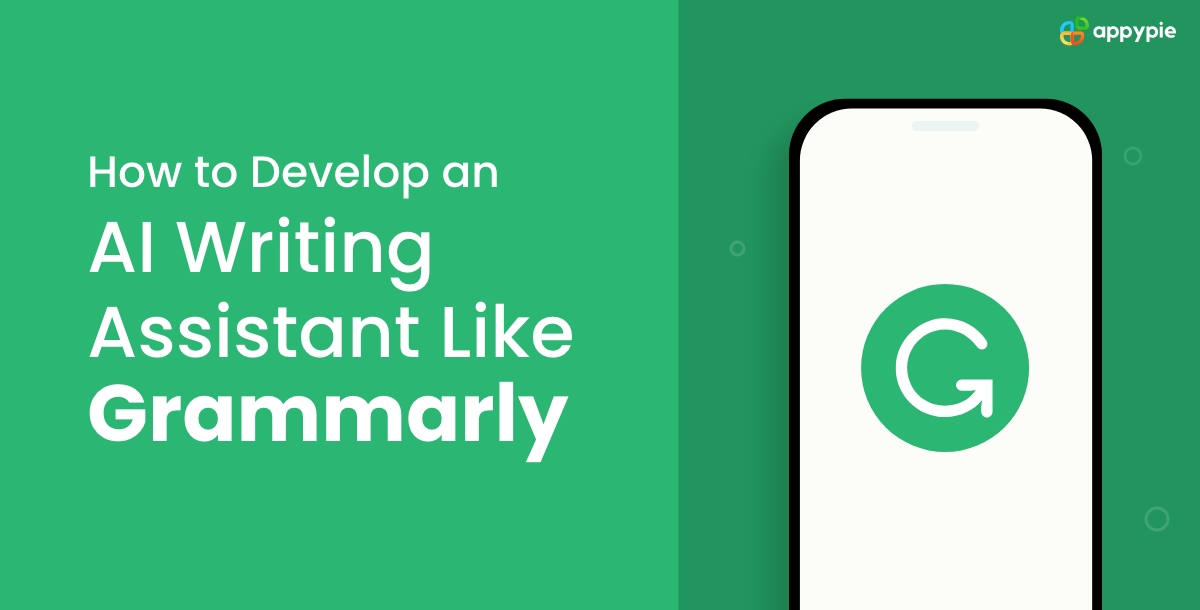How to Develop an AI Writing Assistant Like Grammarly

The rise of AI-powered writing assistants has made tools like Grammarly essential for many users. These apps help improve writing by checking grammar, style, tone, and more. If you're interested in developing an AI writing assistant like Grammarly, you're in the right place. With advancements in natural language processing (NLP) and open-source frameworks, create an app has become more achievable than ever.
In this guide, we’ll walk you through how to develop an AI writing assistant similar to Grammarly using open-source tools and frameworks. Additionally, Appy Pie’s professional services can help if you need assistance with setting up your app.
What is Grammarly?
Grammarly is an AI-powered writing assistant that helps users improve their writing by checking for grammar, spelling, punctuation, and style. It uses advanced AI and natural language processing models to suggest changes that make the writing clearer and more concise. It works across various platforms, providing real-time feedback for better communication.
For creating an app similar to Grammarly, you’ll need to focus on:
- Model Selection: Choosing an NLP model to check grammar, style, and tone.
- Error Detection: Developing a system to detect grammar, spelling, and punctuation mistakes.
- User Interface: Designing a simple, easy-to-use interface where users can interact with the app and get suggestions.
If this seems overwhelming, Appy Pie’s professional services team can help with the technical setup.
Steps to Develop an AI Writing Assistant Like Grammarly
Here’s a step-by-step guide on how to create your own writing assistant, similar to Grammarly. Whether you're a beginner or have some experience in app development, these steps will guide you through the process of building a successful AI writing assistant.
Step 1: Understand the Architecture
Before starting development, it's important to understand the basic architecture of a writing assistant like Grammarly:
- Frontend: The user interface where users can type or paste text to be checked.
- Backend: Manages the logic for checking grammar, spelling, and suggesting improvements.
- Database: Stores user data, document history, and suggestions.
- NLP Model: Powers the error detection and writing suggestions.
Step 2: Set Up the Environment
To start building, you’ll need:
- Programming Knowledge: Familiarity with Python, JavaScript, or other relevant languages.
- Cloud Platform: Platforms like AWS, Google Cloud, or Azure for deployment.
- Open-Source Tools: Utilize frameworks and repositories that support NLP and AI model integration.
Install essential tools such as Python, Node.js, Docker, and Git to set up your development environment. If you need technical assistance, Appy Pie’s professional services team can provide the support you need.
Step 3: Choose an NLP Model
A writing assistant like Grammarly relies heavily on NLP models for tasks like grammar checking, tone analysis, and error correction. Here are some options you can use:
- OpenAI GPT Models: These models offer advanced NLP capabilities, which can help detect grammar errors and provide suggestions.
- SpaCy: An open-source NLP library that supports text analysis, including grammar checking.
- Hugging Face Models: You can use models like BERT or GPT-Neo to check sentence structure and grammar.
Here’s an example of how to install and use a pre-trained model:
pip install transformers
from transformers import AutoModelForSequenceClassification, AutoTokenizer
tokenizer = AutoTokenizer.from_pretrained("bert-base-uncased")
model = AutoModelForSequenceClassification.from_pretrained("bert-base-uncased")
Step 4: Implement Grammar and Error Detection
Next, you’ll need to build the grammar-checking and error-detection system. You can use machine learning and NLP techniques to identify common errors in text. You’ll need to:
- Build or use an existing grammar-checking algorithm.
- Implement a feature to provide suggestions based on detected errors.
Example of using a grammar check with TextBlob:
pip install textblob
from textblob import TextBlob
text = "This are an example sentence."
blob = TextBlob(text)
corrected_text = blob.correct()
print(corrected_text)
Step 5: Build the User Interface
The user interface (UI) is essential for the success of your writing assistant. You need a clean and intuitive design to ensure a smooth user experience. Consider using frameworks like React to build the frontend:
npx create-react-app grammar-checker
This will allow you to create an interactive app where users can type or paste text to receive suggestions.
Step 6: Integrate Frontend with Backend
Set up the backend to process requests from the frontend. You can use FastAPI or Flask to handle these requests and return grammar check results. Example with FastAPI:
from fastapi import FastAPI
app = FastAPI()
@app.post("/check_grammar")
async def check_grammar(text: str):
# Grammar check logic here
return {"corrected_text": "Corrected text goes here"}
Step 7: Test and Optimize
Once the basic functionality is set up, it’s time to test your app. Focus on:
- Accuracy: Ensure the grammar and error detection is correct.
- Performance: Check how quickly the app processes and suggests corrections.
- User Experience: Make sure the UI is user-friendly and intuitive.
Optimize the app by refining the grammar-checking models and improving the UI/UX. Appy Pie’s team can also assist with the testing and optimization process.
Step 8: Appy Pie’s Professional Services
If you find the process too complex, let Appy Pie’s professional services handle the technical details. From setting up NLP models to building the interface and deploying your app, our experts are here to help you create a polished, fully functional AI writing assistant.
Step 9: Deploy Your App
Once your app is ready, it’s time to deploy it. You can deploy the frontend using platforms like:
- Frontend: Vercel, Netlify
- Backend: AWS, Heroku
- Database: Managed database services for scaling
Conclusion
Developing an AI writing assistant like Grammarly can be a rewarding challenge. By using open-source tools and collaborating with Appy Pie’s professional services team, you can turn your idea into reality. Keep experimenting, improving, and refining your app to make it a standout writing assistant!
